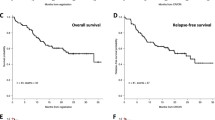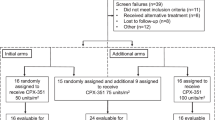Abstract
This phase 1/2 study aimed to identify the maximum tolerated dose, the recommended phase 2 dose (RP2D), and efficacy of the clofarabine, etoposide, and cyclophosphamide combination regimen in adult patients with relapsed/refractory acute lymphoblastic leukemia (ALL). Patients aged ≥ 15 years with relapsed/refractory ALL were enrolled. Escalating doses of clofarabine (20–30 mg/m2/day × 5 days), etoposide (50–100 mg/m2/day × 5 days), and cyclophosphamide (200–440 mg/m2/day × 5 days) were administered. Dose-limiting toxicity was defined as Grade 3 or more non-hematological toxicities and others. A total of 18 patients (B-ALL; n = 13, T-ALL; n = 5) were recruited in phase 1; however, the protocol was amended to close study without proceeding to phase 2. Three patients were enrolled in cohort 1, three in cohort 2, six in cohort 3, and six in cohort 4. The RP2D of clofarabine, etoposide, and cyclophosphamide was 30, 100, and 440 mg/m2 daily, respectively. Complete remission (CR) was achieved in four patients (22%) and CR without platelet recovery in four patients (22%), with an overall response rate of 44%. The RP2D of the combination therapy was successfully determined in this study.
Similar content being viewed by others
References
Dianne P, Adam G, Hermann B. Improvement in survival in younger patients with acute lymphoblastic leukemia from the 1980s to the early 21st century. Blood. 2009;113:1408–11.
Huguet F, Leguay T, Raffoux E, Thomas X, Beldjord K, Delabesse E, et al. Pediatric-inspired therapy in adults with Philadelphia chromosome-negative acute lymphoblastic leukemia: the GRAALL-2003 study. J Clin Oncol. 2009;27:911–8.
Sakura T, Hayakawa F, Sugiura I, Murayama T, Imai K, Usui N, et al. High-dose methotrexate therapy significantly improved survival of adult acute lymphoblastic leukemia: a phase III study by JALSG. Leukemia. 2018;32:626–32.
Fielding AK, Richards SM, Chopra R, Lazarus HM, Litzow MR, Buck G, et al. Medical Research Council of the United Kingdom Adult ALL Working Party; Eastern Cooperative Oncology Group. Outcome of 609 adults after relapse of acute lymphoblastic leukemia (ALL); an MRC UKALL12/ECOG 2993 study. Blood. 2007;109:944–50.
Gökbuget N, Dombret H, Ribera JM, Fielding AK, Advani A, Bassan R, et al. International reference analysis of outcomes in adults with B-precursor Ph-negative relapsed/refractory acute lymphoblastic leukemia. Haematologica. 2016;101:1524–33.
Kako S, Kanamori H, Kobayashi N, Shigematsu A, Nannya Y, Nakamae M, et al. Outcome after first relapse in adult patients with Philadelphia chromosome-negative acute lymphoblastic leukaemia. Br J Haematol. 2013;161:95–103.
Frey NV, Luger SM. How I treat adults with relapsed or refractory Philadelphia chromosome-negative acute lymphoblastic leukemia. Blood. 2015;126:589–96.
Kantarjian H, Stein A, Gökbuget N, Fielding AK, Schuh AC, Ribera JM, et al. Blinatumomab versus chemotherapy for advanced acute lymphoblastic leukemia. N Engl J Med. 2017;376:836–47.
DeAngelo DJ, Stock W, Stein AS, Shustov A, Liedtke M, Schiffer CA, et al. Inotuzumab ozogamicin in adults with relapsed or refractory CD22-positive acute lymphoblastic leukemia: a phase 1/2 study. Blood Adv. 2017;15:1167–80.
Maude SL, Frey N, Shaw PA, Aplenc R, Barrett DM, Bunin NJ, et al. Chimeric antigen receptor T cells for sustained remissions in leukemia. N Engl J Med. 2014;371:1507–17.
Jeha S, Gandhi V, Chan KW, McDonald L, Ramirez I, Madden R, et al. Clofarabine, a novel nucleoside analog, is active in pediatric patients with advanced leukemia. Blood. 2004;103:784–9.
Koh K, Ogawa C, Okamoto Y, Kudo K, Inagaki J, Morimoto T, et al. Phase 1 study of clofarabine in pediatric patients with relapsed/refractory acute lymphoblastic leukemia in Japan. Int J Hematol. 2016;104:245–55.
Hijiya N, Gaynon P, Barry E, Silverman L, Thomson B, Chu R, et al. A multi-center phase I study of clofarabine, etoposide and cyclophosphamide in combination in pediatric patients with refractory or relapsed acute leukemia. Leukemia. 2009;23:2259–64.
Kantarjian HM, Gandhi V, Kozuch P, Faderl S, Giles F, Cortes J, et al. Phase I clinical and pharmacology study of clofarabine in patients with solid and hematologic cancers. J Clin Oncol. 2003;21:1167–73.
Kantarjian H, Gandhi V, Cortes J, Verstovsek S, Du M, Garcia-Manero G, et al. Phase 2 clinical and pharmacologic study of clofarabine in patients with refractory or relapsed acute leukemia. Blood. 2003;102:2379–86.
Hijiya N, Thomson B, Isakoff MS, Silverman LB, Steinherz PG, Borowitz MJ, et al. Phase 2 trial of clofarabine in combination with etoposide and cyclophosphamide in pediatric patients with refractory or relapsed acute lymphoblastic leukemia. Blood. 2011;118:6043–9.
Storer BE. Design and analysis of phase I clinical trials. Biometrics. 1989;45:925–37.
Rijneveld AW, Holt B, Weerdt O, Biemond BJ, Loosdrecht A, Petersen E, et al. Clofarabine added to standard treatment in adult patients with newly diagnosed ALL: first results of the randomized phase III HOVON-100 Study. Blood. 2017;130(Supplement 1):2606.
Koller CA, Kantarjian HM, Thomas D, O’Brien S, Rios MB, Kornblau S, et al. The hyper-CVAD regimen improves outcome in relapsed acute lymphoblastic leukemia. Leukemia. 1997;11:2039–44.
Camera A, Annino L, Chiurazzi F, Fazi P, Cascavilla N, Fabbiano F, et al. GIMEMA ALL—rescue 97: a salvage strategy for primary refractory or relapsed adult acute lymphoblastic leukemia. Haematologica. 2004;89:145–53.
Specchia G, Pastore D, Carluccio P, Liso A, Mestice A, Rizzi R, et al. FLAG-IDA in the treatment of refractory/relapsed adult acute lymphoblastic leukemia. Ann Hematol. 2005;84:792–5.
Möttönen M, Uhari M, Lanning M, Tuokko H. Prospective controlled survey of viral infections in children with acute lymphoblastic leukemia during chemotherapy. Cancer. 1995;75:1712–7.
Jabbour E, Ravandi F, Kebriaei P, Huang X, Short NJ, Thomas D, et al. Salvage chemoimmunotherapy with inotuzumab ozogamicin combined with mini-hyper-CVD for patients with relapsed or refractory Philadelphia chromosome-negative acute lymphoblastic leukemia: a phase 2 clinical trial. JAMA Oncol. 2018;4:230–4.
Gossai N, Verneris MR, Karras NA, Gorman MF, Patel NJ, Burke MJ. A clofarabine-based bridging regimen in patients with relapsed ALL and persistent minimal residual disease (MRD). Bone Marrow Transplant. 2014;49:440–2.
Acknowledgements
The authors thank all investigators and members of participating hospitals in ALL studies conducted by the JALSG.
Funding
This work was supported in part by a grant for Practical Research for Innovative Cancer Control Grant No. JP19ck0106331 from the Japan Agency for Medical Research and Development (AMED).
Author information
Authors and Affiliations
Consortia
Contributions
Administrative support: all authors. Conception and design: all authors. Provision of study materials or patients: all authors. Collection and assembly of data: AMS. Data analysis and interpretation: AH. Manuscript writing: all authors. Final approval of manuscript: all authors.
Corresponding author
Ethics declarations
Conflict of interest
Hitoshi Kiyoi reports research funding from Chugai Pharmaceutical, Kyowa Kirin, Zenyaku Kogyo, FUJIFILM, Daiichi Sankyo, Astellas Pharma, Otsuka Pharmaceutical, Nippon Shinyaku, Eisai, Pfizer Japan, Takeda Pharmaceutical, Novartis Pharma, Sumitomo Dainippon Pharma, Sanofi, Perseus Proteomics and Celgene, and consulting fees from Astellas Pharma, Amgen Astellas BioPharma, and Daiichi Sankyo, and honoraria from Bristol-Myers Squibb, Astellas Pharma, and Novartis Pharma. Yasushi Miyazaki reports research funding from Sumitomo Dainippon Pharma, Pfizer Japan, Chugai Pharmaceutical, and Takeda Pharmaceutical, and honoraria from Chugai Pharmaceutical, Kyowa Kirin, Astellas Pharma, Otsuka Pharmaceutical, Nippon Shinyaku, Novartis Pharma, Sumitomo Dainippon Pharma, and Celgene. Other authors declare that they have no conflict of interest.
Additional information
Publisher's Note
Springer Nature remains neutral with regard to jurisdictional claims in published maps and institutional affiliations.
About this article
Cite this article
Saito, T., Hatta, Y., Hayakawa, F. et al. Combination of clofarabine, etoposide, and cyclophosphamide in adult relapsed/refractory acute lymphoblastic leukemia: a phase 1/2 dose-escalation study by the Japan Adult Leukemia Study Group. Int J Hematol 113, 395–403 (2021). https://doi.org/10.1007/s12185-020-03032-3
Received:
Revised:
Accepted:
Published:
Issue Date:
DOI: https://doi.org/10.1007/s12185-020-03032-3




